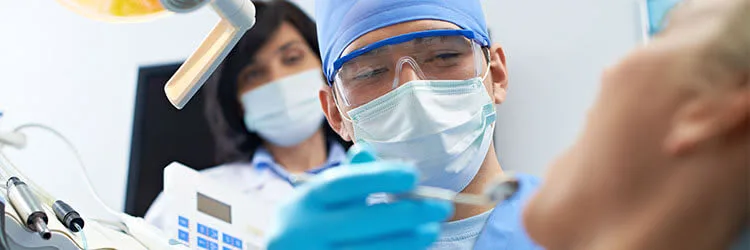There are several types of gum surgeries that your dentist might recommend if you’ve developed gum disease. The most common cause of gum disease is when excessive bacteria builds up in your mouth and creates excess plaque and your body is unable to fight the infection. Certain factors, however, including medications and chronic illnesses, can make someone more susceptible to gum disease even if he or she follows a thorough oral care routine.
Different Types of Gum Surgery
If you’ve developed gum disease severe enough to require surgery, your dentist may discuss some of these types of gum surgery as ways to treat the problem:
Pocket reduction (also known as gingival flap surgery)
In this procedure, your surgeon folds back the gums and removes bacteria. The periodontist (gum specialist) secures the gum tissue against your teeth, rather than allowing it to grow back on its own.
Regeneration
In this procedure, your periodontist folds back the gums and removes disease-causing bacteria, then inserts bone grafts, membranes, or tissue-stimulating proteins (or any combination of the three) to encourage your gum tissues to regenerate and fit snugly around the teeth again.
Crown lengthening
In this procedure, your periodontist removes an overgrowth of gum tissue from your teeth, making your teeth appear longer. This procedure is used for cosmetic effects as well as to treat gum disease.
Soft tissue graft
In this procedure, your periodontist takes sample tissue from elsewhere in your mouth and attaches it to your gums to replace gum tissue that has receded or has been removed due to gum disease. This procedure is often used for cosmetic purposes as well as to treat gum disease because it covers areas where the root is becoming exposed and improves the appearance of the teeth.
If a thorough examination by your dental professional determines that you need gum surgery, you will probably be referred to a periodontist, a doctor who specializes in the treatment of gum disease.
What to Expect with Gingival Flap Surgery
Gingival flap surgery is the type often used to treat gum disease. If you’re scheduled to undergo gingival flap surgery, here’s what to expect:
Before the surgery
Before any gum surgery, you will receive a local anesthetic to numb the area. Also, your periodontist (or dental hygienist) will clean your teeth. You should expect your periodontist to ask about any medications and chronic health conditions that may impact the surgery.
During the surgery
The surgeon folds the gums back to form a flap in order to access the tissue below the gums. The infected tissue below and between the teeth is removed, and the surgeon then follows with tooth scaling and root planing to remove plaque and bacteria below the gum line. The scaling and planing will also smooth rough spots on the tooth roots that could promote recurrence of the gum disease.
After the surgery
The surgeon will put the gums back in place using stitches. The stitches may be dissolvable, or you may have to have them removed when you return for a surgery follow-up visit in seven to 10 days. The surgeon may also place a special surgical dressing called a periodontal pack, over the affected area.
Is Gum Surgery Painful?
Most people have only mild to moderate pain after surgery that can be managed with over-the-counter pain relievers. If you develop moderate swelling, try applying an ice pack to the area. And if your periodontist recommends antibiotics, be sure to follow the instructions carefully. There is some risk of bleeding and swelling after gum surgery. Contact your periodontist immediately if you experience problems.

Sign Up
for expert advice and exclusive offers










